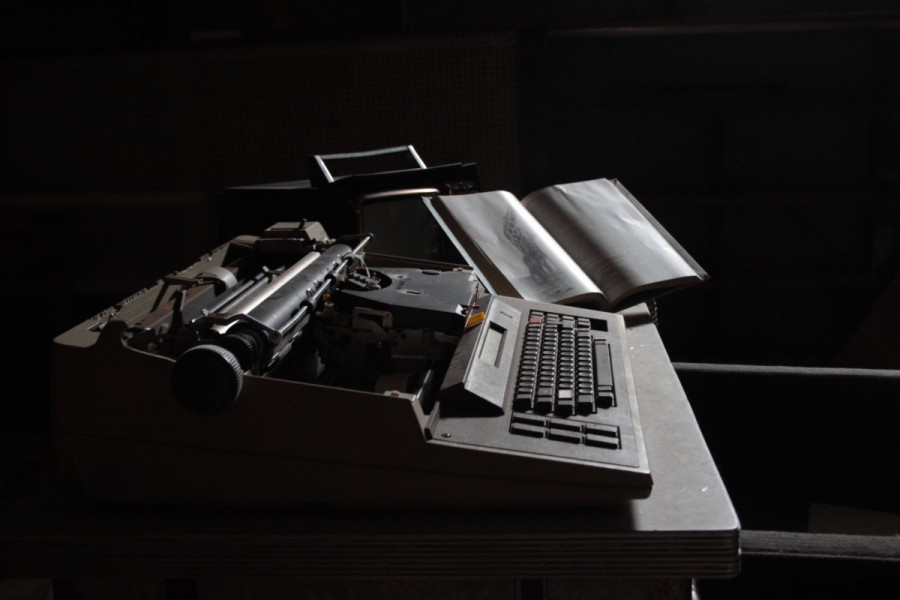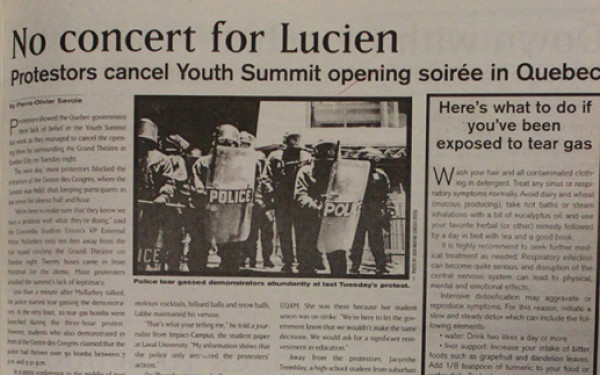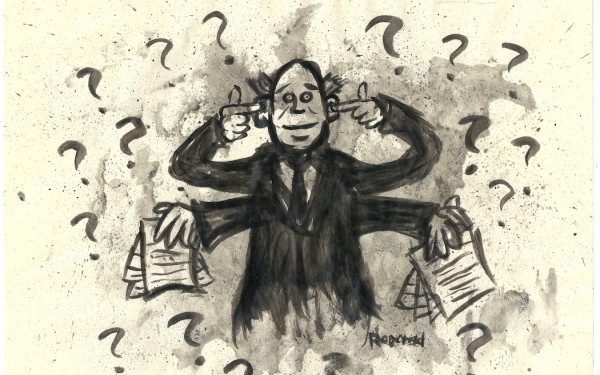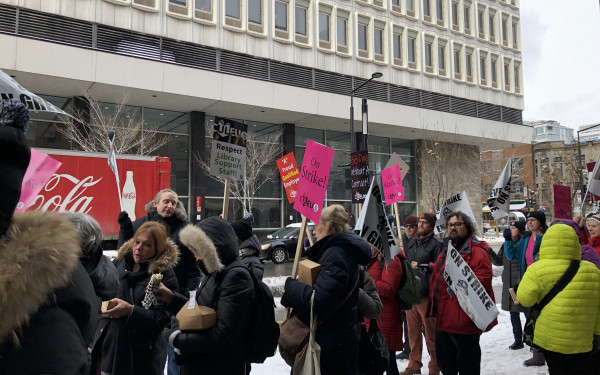Community Archives Open Up a Global Past
Concordia History Class Sifts Through NCC Archives
Steps away from Georges-Vanier Metro station in Little Burgundy stood a stone building.
This article has been updated.
Its age was visible—the cracks and discolouration in the cement addition told passersby that it had long been out of order. Its front doors were boarded up but colourful; an artist had painted testimonies to the building’s past on the sheets of plywood; bright oranges, yellows and greens contrasted with the dark grey stone. Graffiti artists quickly turned the boards into canvases of their own.
But on the inside of the building, time was frozen: a typewriter sitting on an uneven desk, an encyclopedia strewn across the ground, film reels unwound, piano keys stuck and unable to be played.
Stepping into the former Negro Community Centre gave a glimpse into what once was.
The NCC closed the doors to its Coursol St. location in 1989, two years after one of its walls collapsed. The building was 123 years old—it had served the community as a Methodist church until the NCC took over the space in 1928, one year after the Centre’s founding in 1927.
And then, in 2014, it was all gone. A wall had collapsed, tearing through all three floors of the building, seven months earlier. By November, it was deemed a public safety hazard and despite the community’s objection, it was demolished.
A few relics survived the building’s deterioration. Now, they’re in Concordia’s hands.
In 1998, while the Centre’s board tried to save the building, the Concordia library was asked to safely house their archives. They were put into deep storage, history professor Steven High explained.
Over 100 boxes sat in the library’s Special Collection archives for safekeeping until 2013, when Shirley Gyles, the NCC’s former president, officially donated the collection to the university. Four years later, an undergraduate history class is finally digging in.
“No one has had the opportunity to access this archive,” said High. “The idea is, ‘What’s in these boxes and how can we share it back to the community and the wider public?’”
High, along with Alexandra Mills, the library’s special collections archivist, and Désirée Rochat, a specialist on community archives, are leading a group of 35 students as they search for stories in the archives.
“It’s such a rich archive,” said Mills. “It contains so much documentation about the centre, its members, and about the community that it was a part of.”
_900_600_90.jpg)
High agreed. In reviewing the documents contained within these boxes, he explained, students can explore “different pathways into the past.” These boxes, he said “are the foundation” to connecting the links between the Montreal Black community to its global history.
Rochat explained that that is exactly the purpose of community archives—they open history up to the world. Rochat’s doctorate, in progress at McGill’s Department of Integrated Studies in Education, focuses on these types of archives. “It’s really community-based research,” she said.
This work, she explained, coincides with her work of a similar nature with the Maison D’Haiti in St. Michel. “It’s kind of like these two Black community organizations that end up playing a key role in […] offering services to their wider neighbourhood communities.” she said. “They’re kind of anchors, in their own ways.”
“What’s interesting,” High continued, “is that often, state archives are very much top down, and so it’s hard to tease out marginalized voices.” These archives, rather, contain a unique collection of personal records, photographs, correspondences and official documents from the Centre.
“It’s usually the powerful whose stories are archived,” he said. “But here we have an archive of very much a marginalized community within Montreal.”
“That’s a physical erasure but that’s also very symbolic of the erasure of a Black presence in the city.” – Désirée Rochat
Rochat agreed. “The work around these archives is definitely necessary, because I think that there’s a lot of these histories that otherwise do not get told.”
The purpose of delving into these boxes, Rochat said, “is so that the community can have access again to its own memory and its own past.”
A student in the course, Nicola Sibthorpe, said that her favourite thing in the archival box she was searching was a photo of teenagers during one of the centre’s programs, sitting in a tree. The photos, she explained, give a good sense of how Montreal has changed in the years since the centre’s operation.
Sibthorpe continued that the documentation connects the history of the NCC to that of the greater Little Burgundy community. In her box, she found an article about the Union United Church, which was founded in 1907, that is still active today.
As a Swiss-Haitian originally from the Caribbean, Rochat spoke from experience. She said that she learned the Caribbean history of Montreal through organizations like the NCC.
“The archives of community organizations held an important chunk of history,” explained Rochat. “But they also hold a lot of pragmatic information as to what organizing has been done, what community education has been done, and as an educator, they are resources on their own.”
While chance made it that this project coincides with Montreal’s 375th anniversary, High insists that this was not intentional. He said the decision to explore the documents now was inspired in part by the community’s own milestone. “It’s actually aligned with the 90th anniversary of the NCC,” he said.
2017 is also the 100th anniversary of the Order of Sleeping Car Porters, High explained. The order was an all-Black union formed of railway workers at a time when unions and employers were still highly segregated. “They organized themselves to resist, and to push not only the employers, but other unions to open themselves up.”
The timing, he said, provides the opportunity to “open that jar a bit and break it out of that purely national narrative, and think about what this history means to other kinds of communities in Montreal and in Canada.”
He reaffirmed that it’s equally important to acknowledge these anniversaries in their own right. “No one is talking about those anniversaries and I think they’re important too.”
On the 375th celebrations, Rochat explained, “There are a lot of questions on what we are remembering and how we are remembering it.”
Telling the narrative of Montreal as a city that is 375 years old, she explained, is telling a narrative of erasure, of forgetting the people who inhabited the land before the arrival of French settlers. “There’s the construction of a very linear and non-diverse history of Montreal,” she said.
The NCC, Rochat said, is an example of that erasure. In the years between the community’s evacuation from the Little Burgundy site and its eventual demolition, she explained, NCC members pushed to have the building recognized as a heritage site due to its importance in the historical and political landscape.
Despite their lobbying, both to save the building and to have it preserved, it was torn down. The Link reported last year, on the anniversary of the building’s demolition, that some felt as though the centre’s board had not done enough to ensure the building’s survival.
“That’s a physical erasure,” Rochat said, “but that’s also very symbolic of the erasure of a Black presence in the city.”
A previous iteration of this article referred to the Order of Sleeping Car Porters as the Brotherhood of Sleeping Car Porters. The Link regrets this error.


_600_832_s.png)


2_900_719_90_600_375_90_s_c1.jpg)

